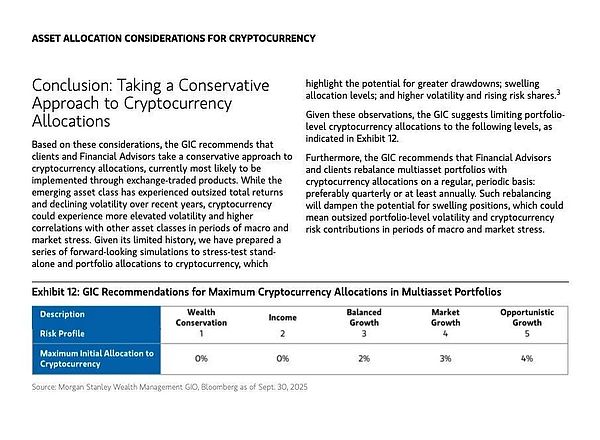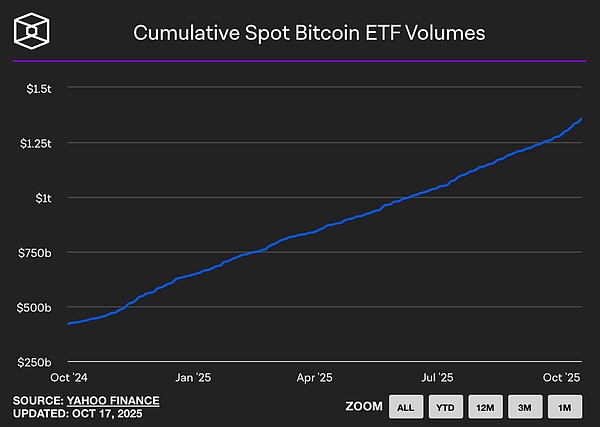
author:Thejaswini

Preface
For much of the 20th century, the answer to this question was simple: your employer decided.The company provides the pension, manages the investments, and assumes the risk.If the fund performs well, they keep the extra earnings; if the fund performs poorly, they cover the shortfall.You have no say, but you have nothing to lose.
Then, the advent of 401(k) plans shifted the responsibility onto the individual.You choose the investments and take the risks.But your choice is not completely free.Employers still act as gatekeepers, offering only a “prudent” set of options.Initially, courts had deemed common stocks too risky for retirement accounts.Later, index funds were considered too passive.Definitions of prudence evolve, but paternalism remains.
On October 15, 2025, Morgan Stanley redrawn the lines.The company’s 16,000 financial advisors can now recommend Bitcoin investments to any client, including those with IRAs and 401(k)s.There are no minimum wealth requirements and no aggressive risk tolerance requirements.Bitcoin is just quietly showing up, along with bonds and blue-chip stocks, in investment portfolios funding senior Americans.
The risks are huge.U.S. retirement assets total $45.8 trillion.Even a shift of just 1% of asset allocations to cryptocurrencies would mean $270 billion flowing into the market.If it’s 2%, that’s over $500 billion.
What’s the beautiful math behind this?I have some thoughts to share.
Morgan Stanley Opens Up a New Era of Cryptocurrency Retirement Investing
Until last October, Morgan StanleyLimit access to cryptocurrencies to those with assets over $1.5 million and risk toleranceCustomers who are aggressive and have taxable brokerage accounts.Retirement accounts are completely prohibited.
These restrictions no longer exist.
Advisors do not purchase Bitcoin directly for clients.on the contrary,They allocate funds into regulated crypto investment products, primarily from BlackRock and FortuneBitcoin ETF.In the future, once approved,Ethereum and Solana ETFs may be included in the future.
The company’s automated portfolio system tracks each client’s crypto asset exposure in real time to prevent excessive concentration.Morgan Stanley’s Global Investment Council recommends, for young or aggressive investors, an allocation of 4% to an “Opportunistic Growth” portfolio, 2% to a Balanced Growth portfolio, and 0% to a preservation or income strategy.
These restrictions are a legal shield.Under the Employee Retirement Income Security Act of 1974 (ERISA), the law that governs retirement plans and defines “prudent” investing, companies that sponsor 401(k) plans have a fiduciary duty to act in the best interests of participants.If a company offers imprudent or excessively risky investments without proper supervision, participants can sue for losses.To succeed, the plaintiff must prove that the trustee breached its duties by providing unsuitable investments or insufficient management controls.
Morgan Stanley’s 4% cap and real-time risk monitoring are designed to protect against such lawsuits.The company is betting that conservative allocation limits and real-time risk monitoring will protect it from accusations that it inadvertently exposed retirees to cryptocurrency volatility.Whether this defense holds true when Bitcoin is down 70% has yet to be tested.

Advisors must record encrypted referrals through an internal system.The compliance team ensures clients confirm volatility disclaimers and risk tolerance adjustments before investing.
While the Bitcoin ETF is available immediately, Morgan Stanley-owned E-Trade platform will launch direct Bitcoin, Ethereum and Solana trading in 2026, powered by Zerohash infrastructure.
This is still highly regulated, with risk scoring and allocation software strictly constrained.But it effectively turned cryptocurrencies into a mainstream investment option accessible through 80% of U.S. retirement accounts managed by Morgan Stanley.
Why now?The policy window has just opened
Three regulatory changes set the stage for Morgan Stanley’s move.
First, an executive order signed by President Trump in August directed the Department of Labor (DOL) and Securities and Exchange Commission (SEC) to revisit the rules for alternative investments in 401(k)s and IRAs.The order effectively rewrites the boundaries of retirement investing, signaling to financial institutions that regulatory backlash is no longer an issue.
Second, the GENIUS Act signed in July established the first comprehensive stablecoin regulation in the United States.By requiring 1:1 USD reserve backing and quarterly audits, the law reduces systemic vulnerabilities and gives institutions confidence that crypto infrastructure now has regulatory legitimacy.
Third, the Labor Department reversed its 2022 cautious stance on cryptocurrencies in retirement plans.By allowing fiduciaries to evaluate crypto investments under traditional ERISA standards, the Department of Labor is normalizing the inclusion of cryptocurrencies in 401(k)s and IRAs without the need for special exemptions.
Together, these changes create a narrow policy window.Morgan Stanley was the first mainstream wealth manager to seize the opportunity, while rivals such as Fidelity and Schwab were slower to move as exposure limits were still being debated by internal risk committees.
Wall Street interpreted regulatory signals and concluded that the risks of not offering cryptocurrency now outweigh the risks of offering it.But there’s a deeper current driving this shift: what institutions now call“Currency Depreciation Transaction”.
This is consistent with arguments that have been made by gold enthusiasts and Bitcoin supporters for years.Central banks will not stop printing money.Fiat currency will lose purchasing power.Traditional safe-haven assets like gold are surging, the U.S. dollar index is in a multi-year downtrend and investors are turning to fixed-supply assets.What was once a fringe idea has now become an institutional consensus.Bitcoin is now designed to be a devaluation-resistant asset: fixed supply, transparent issuance, trustless verification.When the currency itself is repriced, Bitcoin looks less like speculation and more like a store of capital.
next steps
Morgan Stanley’s decisive move puts pressure on other wealth managers with retirement businesses.Here’s a look at the current status of the major players.
Fidelity launched a fee-free cryptocurrency IRA in 2022 and now offers a spot Bitcoin ETF.As the largest 401(k) provider by assets, holding more than a third of U.S. accounts, Fidelity has expanded to include Ethereum and Solana funds.However, it has yet to integrate cryptocurrencies into the retirement portfolios that advisors manage on a day-to-day basis.
BlackRock’s Bitcoin ETF (IBIT) holds $84 billion in assets, accounting for 57% of the Bitcoin ETF market.It is the fastest-growing ETF in history and could hit $100 billion in 450 days.BlackRock’s advantage lies in product dominance, not distribution channels.

Schwab plans to launch cryptocurrency spot trading in 2026, targeting Gen Z investors, who account for 33% of new accounts and are under the age of 28.Schwab plans to launch a full suite of products in early 2026, but has not yet opened access to retirement accounts.
Vanguard, which manages $10 trillion in assets, is moving away from crypto-assets after years of resistanceExplore access to third-party crypto ETFs.Vanguard’s policy shift has been driven by client pressure and BlackRock’s new CEO, making it more open to cryptocurrencies.Among the major players, however, Vanguard remains the most cautious.
Goldman Sachs viaGS DAP platform in partnership with BNY Mellon, focusing on tokenized money market funds,Provide on-chain fund recording services.The company is building out infrastructure for tokenized assets rather than pursuing retail crypto exposure.
The broader banking sector is also taking action.JPMorgan is expanding its JPM Coin for cross-border settlement and to serve crypto funds.Citigroup plans to launch digital asset custody services in 2026 and participates in the G7 Stablecoin Alliance.Bank of America, Deutsche Bank, UBS and Barclays are all participating in the multi-national stablecoin research group.
A new player to watch is Erebor Bank, a Columbus, Ohio-based bank founded by billionaires Palmer Luckey and Joe Lonsdale, both Trump supporters.Erebor received conditional approval from the U.S. Office of the Comptroller of the Currency (OCC) in October.The technology and cryptocurrency-focused bank aims to serve emerging businesses in areas such as artificial intelligence and digital assets.Its approval signals that the regulatory door is opening to institutions specializing in cryptocurrency banking.
Traditional institutions are racing to integrate cryptocurrencies into existing wealth management infrastructure, while new players are building crypto-native tracks from scratch.
While Morgan Stanley’s move brings cryptocurrencies to individual retirement accounts, state pension funds have been quietly accumulating Bitcoin for more than a year.
Wisconsin and Michigan disclosed holdings in BlackRock’s IBIT and ARK Bitcoin ETFs, totaling nearly $400 million.
The risk preferences of ordinary people and Wall Street institutional investors are converging at an accelerated pace.Pension funds inbound by fiduciary dutiesIt operates under a system, which means its administrators must demonstrate that every allocation is prudent and in the best interests of the beneficiaries.If they are willing to invest in Bitcoin, it is because they believe the diversification benefits and asymmetric upside outweigh the volatility risks.
Now, via Morgan Stanley, retirement accounts are joining the ranks, underscoring a massive but stealthy reallocation of long-term savings toward digital assets.A conservative strategy limits exposure to 5% of the portfolio, while an aggressive allocation could be as high as 35%, depending on risk tolerance.
Bitwise analysts estimate that 1-2% of the $45.8 trillion in retirement assets moving into cryptocurrencies, equivalent to $450 billion to $900 billion in inflows, could push Bitcoin to $200,000.The first tranches of funds could arrive this fall, coinciding with a potential Federal Reserve interest rate cut.
But if cryptocurrencies fell 70%, that would be a $300 billion hit to retirement that could ripple through consumer spending and erode trust in retirement advisors.
What happens when everyone else follows suit?
Analysts at Deutsche Bank predict that by 2030, central banks are likely to hold large amounts of Bitcoin and gold due to institutional penetration and a weaker dollar.Gold has crossed 4,000 an ouncedollar mark,And Bitcoin is trading slightly below its all-time high.
The dollar’s share of global reserves fell from 60% in 2000 to 41% in 2025.The decline drove record inflows into gold and Bitcoin ETFs, which reached $5 billion and $4.7 billion in June alone.
JPMorgan analysts estimate that growth in the stablecoin market could translate into $1.4 trillion in additional U.S. dollar demand by 2027, although this depends on overseas investment interest.The interplay between the rise of Bitcoin, stablecoin adoption and dollar hegemony is still unfolding.
What is clear, however, is that retirement portfolios are being rebuilt with Bitcoin ETFs, whether regulators, advisors, or retirees fully understand the implications.
If Fidelity, Schwab, and Vanguard follow Morgan Stanley’s lead, the industry will essentially decide that cryptocurrencies are no longer an alternative asset.It has become a core asset.






